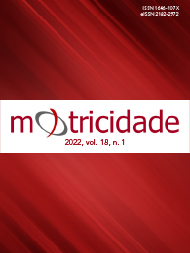Body Image, Muscle Dysmorphia, and Muscularity Concerns: A Comparison of CrossFit Athletes, Weight-Trainers, and Non-Athletes
DOI:
https://doi.org/10.6063/motricidade.25584Keywords:
Body appreciation, Body dissatisfaction, Sport, Physical activity, Muscle concernsAbstract
CrossFit is a strength-and-conditioning physical activity programme that some studies have shown results in healthier body image outcomes. However, prior studies have typically examined CrossFit in isolation, without adequate group comparison. This study aimed to investigate body image experiences in CrossFit athletes in comparison to weight-trainers and non-athletes. The study used a cross-sectional design in which CrossFit athletes, weight-trainers, and non-athletes from Brazil were asked to complete a measure of positive body image (i.e., body appreciation), negative body image (i.e., body dissatisfaction), and gender-specific muscle-oriented body image (i.e., muscularity concerns in women and muscle dysmorphia symptomatology in men). Between-group comparisons showed that CrossFit athletes and weight-trainers had healthier body image than non-athletes, but differences between the two groups were small. There were no significant between-group differences in muscularity concerns in women, whereas weight-training men had a significantly higher drive for size compared to both CrossFit athletes and non-athletes. Male CrossFit athletes and weight-trainers also showed significantly higher functional impairment as a result of exercise compared to non-athletes. These results suggest that participation in CrossFit may be a route to promoting a healthier body image while mitigating unhealthy muscularity-related attitudes and behaviours. More broadly, our results support the suggestion that physical activity is associated with a healthier body image.
Keywords: Body appreciation; Body dissatisfaction; Sport; Physical activity; Muscle concerns; CrossFit
Downloads
Published
Issue
Section
License
The authors of submitted manuscripts must transfer the full copyright to Journal Motricidade / Sílabas Didáticas Editions. Granting copyright permission allows the publication and dissemination of the article in printed or electronic formats, and copyrights start at the moment the manuscript is accepted for publication. It also allows Journal Motricidade to use and commercialise the article in terms of licensing, lending or selling its content to indexation/abstracts databases and other entities.
According to the terms of the Creative Commons licence, authors may reproduce a reasonable number of copies for personal or professional purposes, but without any economic gain. SHERPA/RoMEO allows authors to post a final digital copy (post-printing version) of the article on their websites or on their institutions' scientific repository.


